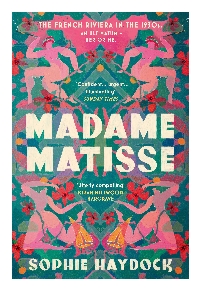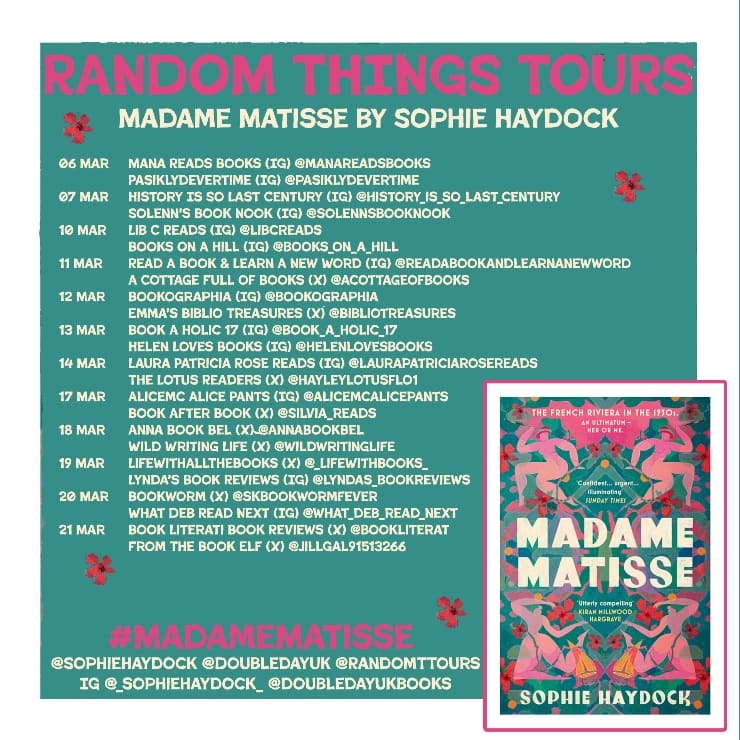Blog tour: Madame Matisse by Sophie Haydock

This post is part of a blog tour organised by Random Things Blog Tours. I received a free copy of the book in return for an honest review.
‘This is the story of three women – one an orphan and refugee who finds a place in the studio of a famous French artist, the other a wife and mother who has stood by her husband for nearly forty years. The third is his daughter, caught in the crossfire between her mother and a father she adores.
‘Amélie is first drawn to Henri Matisse as a way of escaping the conventional life expected of her. A free spirit, she sees in this budding young artist a glorious future for them both. Ambitious and driven, she gives everything for her husband’s art, ploughing her own desires, her time, her money into sustaining them both, even through years of struggle and disappointment.
‘Lydia Delectorskaya is a young Russian emigrée, who fled her homeland following the death of her mother. After a fractured childhood, she is trying to make a place for herself on France’s golden Riviera, amid the artists, film stars and dazzling elite. Eventually she finds employment with the Matisse family. From this point on, their lives are set on a collision course…
‘Marguerite is Matisse’s eldest daughter. When the life of her family implodes, she must find her own way to make her mark and to navigate divided loyalties.’

Madame Matisse, by Sophie Haydock, follows three women in the life of Henri Matisse: his wife, Amélie, who takes a risk in marrying a fledgling artist and ends up unfulfilled in her own ambitions; his eldest child (from a previous relationship), Marguerite, who’s devoted to her father and raised by Amélie as her own; and Lydia, an orphaned Russian exile who becomes Matisse’s muse in his later years, leading Amélie to issue an ultimatum: ‘her or me’.
Spanning just over a century, with scenes in Paris, Nice, Russia, and China, we see how the Russian Revolution and World War II impact the characters’ lives, and what it’s like to live in the orbit of a bold, increasingly in-demand painter.
I found Madame Matisse a really interesting page-turner. I’m always up for a novel about the development of an artist’s creative practice and career, but it’s the narratives of the women who surrounded Matisse – who comes across as a disciplined, likeable man, dedicated to his craft above all else – who truly provide this story’s ongoing dramatic draw.
Of the three women, I found Lydia’s story the most compelling. While Amélie experiences hardships, setbacks, and frustrations as she accompanies her husband on his ascent to fame, the Matisses eventually find themselves living in comfortable homes (even if Amélie is not herself comfortable) in suburban Paris and Nice. I often felt quite emotionally removed from Amélie, perhaps due to her gung ho and, later on, spiky demeanour.
In contrast, I couldn’t help but feel sympathy for Lydia, who faces dire hardship and high stakes from a very young age. When she’s seven, accompanied by her aunt (her mother is on the brink of death from cholera, and her doctor father is caring for both her mother and his patients) she flees Siberia for a Russian exile community in Harbin, China. Both of her parents end up dying of disease back in Russia.
The pair manage to scrape a living, but there’s no way Lydia can afford to go to medical school as she’s always dreamed. When she’s in her late teens, her aunt dies and, now totally alone in the world, Lydia decides to move to France and see what she can make of her life there.
Among Lydia’s meagre possessions is the gun her father gave her when she last saw him – we catch sight of this gun in the very first chapter and, being previously unfamiliar with her story, I just had to keep reading to find out who used it against whom!
While Amélie and Marguerite are characterised by their devotion to Matisse for much of the book, Lydia’s taking-over of his care and administration does free them for other pursuits they find meaningful and fulfilling.
Mother and step-daughter’s existences liven up when, both now free of marital bonds, they play roles in the French Resistance during the Second World War. Marguerite’s story becomes particularly hair-raising when she’s captured and tortured by the Gestapo, but escapes while being transported to a concentration camp. Amélie is jailed for six months for her transcription activities, and it might have been interesting to return to her narrative during this period.
Something that really tugged at me while reading this book, and stuck with me afterwards, was the fact that Matisse and Lydia’s close relationship wasn’t sexual (or possibly even romantic, for that matter) – and that Amélie and Marguerite couldn’t fathom that an older man and a younger woman could have such a meeting of minds without sex entering the equation.
I don’t blame Amélie for leaving – she was unhappy enough anyway, without the additional jealousy and suspicion, and there is such thing as an emotional affair – but, from an asexual perspective, it always interests me to encounter the automatic assumption that something sexual must be going on between two people who are platonically, or even sensually or romantically close, because it’s a way of thinking that’s so alien to me.
Similarly, there are insinuations throughout the story of liaisons between artists and their models when, much of the time (but not all – when Lydia’s jobbing as a model, she gives an artist who tries it on a well-deserved slap!), the artist observes the body of the model dispassionately, capturing their shapes with much the same level of sexual interest as they would those in a bowl of fruit.
Madame Matisse is gripping, fascinating, and thought-provoking.
